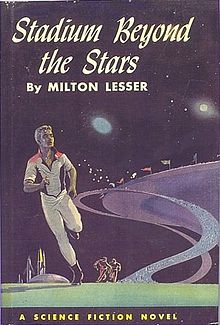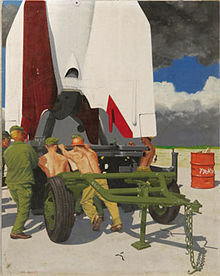- Mel Hunter
-
Mel Hunter Born July 27, 1927
Oak Park, Illinois, United StatesDied February 20, 2004
Ferrisburgh, Vermont, United StatesCause of death Bone cancer Nationality American Education Attended Northwestern University, Evanston, Illinois Occupation Scientific illustrator Known for Science fiction illustration Spouse Susan Smith-Hunter Milford "Mel" Joseph Hunter 111 (July 27, 1927 – February 20, 2004) was a 20th century American illustrator. He enjoyed a successful career as a science fiction illustrator, producing illustrations for famous science fiction authors such as Isaac Asimov and Robert A. Heinlein, as well as a technical and scientific illustrator for clients such as The Pentagon, Hayden Planetarium, and the Massachusetts Audubon Society.
Contents
Biography
Early life
Mel Hunter's life began with a troubled childhood in Oak Park, Illinois, where he was physically and psychologically abused by a humorless father. "He never knew his mother because she was banished from the household by his father when he was only two years old. While he never forgot the abuse, he didn't seem to dwell on it. Instead, he poured himself into his work and career," said his third wife, Susan Smith-Hunter.[1]
Hunter entered college a year early, at Northwestern University in Evanston, Illinois. After college he held a variety of odd jobs, but finally landed a draftsman job at Northrop Aircraft Corp in California. In 1950, Hunter decided to pursue a career in art and began to teach himself illustration in his spare time.
Science Fiction Illustration
With a growing understanding of the fields of astronomy, astronautics, and aviation Hunter set out to teach himself book and magazine illustration. He moved to New York City during the early 1950s, and by 1953 he had successfully sold his first color cover to Galaxy Science Fiction magazine and talked himself into a technical illustrator at Northrop Aircraft where he painted illustrations of advanced aircraft and simulated combat scenarios.
During that time, the most lucrative outlet for space artists was the science-fiction genre. Along with a fertile imagination, Hunter coupled his art with realism and technical accuracy. Hunter's whimsical science fiction robots became his signature to thousands of science fiction fans; the skeletal steel robots graced the covers of the Magazine of Fantasy and Science Fiction well into the 1970s. Hunter's lonely robots were often depicted walking solo through the desolate landscapes of nuclear ruins or alien planets.
Hunter was nominated for the Hugo Award for Best Professional Artist for the years 1960-1962.
Technical and Scientific Illustration
As Hunter's science fiction career blossomed, so did his technical and scientific illustrations. Hunter's love of air and space took him from California's desert runways to Florida's seacoast launchpads to illustrate every variety of jet-age aircraft and space-age rocket imaginable—from X-15 to Saturn V.
One of Hunter's best-known books is "The Missilemen", a photo illustrated work published in 1960 by Doubleday. Hunter visited U.S. rocket and missile sites during the late 1950s; he took all of the book's black-and-white photographs. It was a unique document, a rare look inside the world of rocket scientists and engineers of the early space age. The book, long out of print, is enshrined as a part of space history itself. Another Hunter book, "Strategic Air Command", was also recognized as a pioneering work in photojournalism; it received the Aviation Writers' Association highest honors in 1961.
"Mel launched a career in scientific illustration after he was an established science-fiction illustrator," said Smith-Hunter. "He was very technically accurate and was commissioned to complete 26 paintings of celestial objects for the Hayden Planetarium in New York City."[2]
Hunter's science fiction art quickly led to illustrating hard science and the most advanced aerospace technology of the time. He worked for Northrop Aircraft as a concept illustrator, painting advanced interceptors and drone bombers; all done for Pentagon officials to evaluate when awarding R&D contracts.[citation needed]
Hunter's popularity was literally taking off by the mid 1960s. He created thousands of highly detailed illustrations and paintings for National Geographic, Newsweek, Time-Life Books, and other publications. If astute readers didn't know Hunter by name, they could certainly identify his distinctive style and subjects.
Naturalistic Lithography
After 17 years of technical and scientific illustration, Hunter moved from New York to Chester, Vermont in 1967. He began creating lithographic prints depicting the natural scenes which surrounded him. The following year, he was commissioned to create a series of more than 130 watercolors of "Birds of the Northeast" by Abercrombie & Fitch Galleries and Massachusetts Audubon Society. By 1970, Hunter signed a contract with World Publishing Co. for a series of 13 ecological books for children, dealing with topics like the beginning of the earth, mankind, plants, birds, mammals and insects.
In 1976, after accidental damage to his limestone lithographic drawing, Hunter began using mylar as a medium for his lithography, and published a controversial photo-illustrated article in the American Artist Magazine entitled "Revolution in Hand-Drawn Lithography". In 1984, Hunter published his seminal hardcover textbook, The New Lithography which details the "Mylar Method", still in wide use today.
Death
Although diagnosed with Parkinson's Disease in the 1990s, Hunter died of bone cancer in February 2004. True to his final wish, the cremated remains of this multi-talented artist, aviation expert, and amateur astronomer will be placed aboard a Falcon-1 rocket and launched into space. The private launch, coordinated by Space Services Inc. from Vandenberg Air Force Base in California, was set to launch in 2007.
Finally, launch was scheduled for 3 August 2008 at 03:35 UTC. Details may change as more information becomes available. Current launch details: SpaceX used a Falcon 1 to launch Trailblazer and two CubeSats for the American Air Force and MDA, and for NASA. Launch occurred at Kwajalein Atoll. A Celestis Space burial payload,' Explorers Flight', including the remains of astronaut Gordon Cooper, Star Trek actor James Doohan, and 206 others, including Mel Hunter, was also being flown. A flight anomaly occurred about the time of separation between the first and second stages, which was planned for 2 minutes and 39 seconds after launch and it seems that the rocket never reached orbit. (Susan Smith-Hunter, from Charles Chafer, Celestis)
Hunter shared the final years of life with his third wife, Rutland, Vermont native sculptor Susan Smith-Hunter. The couple opened the Smith-Hunter Gallery during the 1980s at their Ferrisburgh home. The gallery closed in 2007 and Smith-Hunter relocated to Brandon Vermont where she continues a smaller gallery and studio. Mel's work is still available here and through www.smithhuntergallery.com.
Notes
See also
External links
- The Smith-Hunter Gallery - The gallery of Mel Hunter and Susan Smith-Hunter.
Categories:- 1927 births
- 2004 deaths
- Scientific illustrators
Wikimedia Foundation. 2010.



